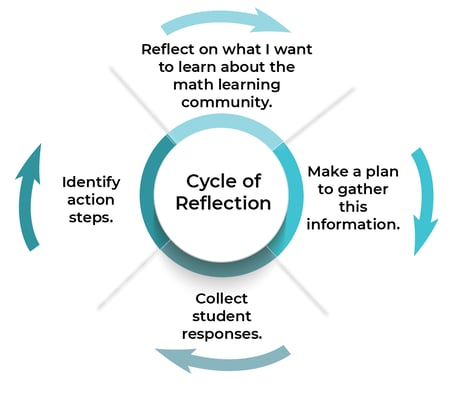TERC Blog
A Cycle of Reflection: Learning More About Our Students
As we prepare for the launch of The Forum for Equity in Elementary Mathematics, we offer a preview of the kind of topics and conversations it will take up, and the kind of thinking and tools it will share — in this case, the power of student reflection. Sign up here to be notified when resources become available, events are announced, or blogs are published.
“I’m hoping to develop a math community where everyone has a voice and I can elevate the voices of students who may not have participated in discussions in the past.”-Berta, Grade 2
Developing an equitable math learning community that centers each student’s identity, needs, and voice requires that teachers take the time to learn about their students and then act on the knowledge they have gained. In the blog, “What Do Your Students Think About Math?: Student Reflection as a Tool for Finding Out,” we offered an invitation to engage students in sharing their experiences and reactions to math class:
When we take time to listen and respond to the feedback students offer, we demonstrate our commitment to fostering a supportive learning community as well as our respect for our students’ contributions. If used regularly, such reflections can help us see how students’ thoughts about mathematics, and about themselves as learners, are changing over time (or not). This choice to pay attention to and respond to students’ needs and current dispositions is a critical step in developing an equitable learning environment.
Interested in learning more about how teachers can develop equitable math learning environments, our team sought input from teachers. We invited a group of elementary math teachers from diverse backgrounds and communities, to work with us on the development and field testing of a variety of Equity Resources. One such resource is a Student Reflection Tool which provides a bank of questions, and sample questionnaires and surveys, that teachers can use to learn more about their students' previous and current math experiences. The Tool is organized into four areas of reflection.
- Students’ prior experiences with mathematics
- Students’ reflections on themselves as math learners
- Students’ beliefs about math and expectations for math class
- Students’ participation in math class
Teachers in the research group—such as Berta, whose quote began this blog—made student reflection an ongoing part of their practice. As they posed questions and collected responses, they found that reflecting on individual students’ answers and on broader trends offered them fertile ground for analyzing their classroom community. Often these responses raised new questions they wanted to investigate and they did so in a variety of ways, by:
- Conducting an individual interview
- Asking a follow up question
- Facilitating a whole class conversation
- Working with a small group who may have exhibited the same needs.
- Reflecting on their practice
For example, Carmen asked her students to write a response to the question: What do you do when something feels hard or challenging for you during math class? She analyzed and then reflected on the responses:
“The responses revealed that my students are feeling challenged and not wanting to share. Perhaps I will facilitate a discussion about what to do when you think something is hard. We’ve had lots of discussions about mistakes and brain growth already, but they may benefit from a discussion about what to do when you’re stuck.”
- Carmen, Grade 3
Over time, teachers’ work suggested a cycle: gathering students’ reflections, analyzing students’ responses, and then identifying action steps.

Teachers examined and wrote about many aspects of students’ math identities and experiences as they used this tool to better understand and respond to their students’ needs. Upcoming blogs on The Forum for Equity in Elementary Mathematics will share stories of some of those teachers, showing the cycle in action.
NOTE: The Student Reflection Tool described in this blog will be published on The Forum for Equity in Elementary Mathematics in October 2023. Launching September 27, this new website is devoted to reflecting on equity, identity, and agency in the teaching and learning of elementary mathematics.
Want to be notified when resources become available, events are announced, or blogs are published?













.jpeg)
